Gini and Entropy-Based Spread Indexes for Primary Energy Consumption Efficiency and CO2 Emission
Abstract
:1. Introduction
2. Methodologies
2.1. Efficiencies in Primary Energy Consumption Technologies in Terms of CO2 Emissions
2.2. Non-Fossil Fuel Use
3. Results and Discussion
3.1. Consumption Technology Efficiency in Terms of CO2 Emissions
3.2. Non-Fossil Fuel Use Global Spread
4. Conclusions
Author Contributions
Funding
Acknowledgments
Conflicts of Interest
Abbreviations
| BTU | British Thermal Unit |
| EIA | Energy Information Administration |
| MM | Million Metric |
| PRI | Principles of Responsible Investment |
| US | United States |
References
- BP. BP Statistical Review of World Energy; BP: London, UK, 2019. [Google Scholar]
- United Nations. Emissions Gap Report; United Nations Environment Programme: Nairobi, Kenya, 2018.
- International Energy Agency. World Energy Outlook 2018; International Energy Agency: Paris, France, 2018. [Google Scholar]
- Awerbuch, S.; Berger, M. Applying Portfolio Theory to EU Electricity Planning and Policy-Making; International Energy Agency/Emerging Energy Technologies: Paris, France, 2003. [Google Scholar]
- Awerbuch, S. Portfolio-based electricity generation planning: Policy implications for renewable and energy security. Mitig. Adapt. Strateg. Glob. Chang. 2006, 11, 693–710. [Google Scholar] [CrossRef]
- Marrero, G.A.; Ramos-Real, F.J. Electricity generation cost in isolated system: The complementarities of natural gas and renewables in the canary islands. Renew. Sustain. Energy Rev. 2010, 14, 2808–2818. [Google Scholar] [CrossRef] [Green Version]
- Losekann, L.; Marrero, G.A.; Ramos-Real, F.J.; Almeida, E.L.F. Efficient power generating portfolio in Brazil: Conciliating cost, emissions and risk. Energy Pol. 2013, 62, 301–314. [Google Scholar] [CrossRef]
- Marrero, G.A.; Puch, L.A.; Ramos-Real, F.J. Mean-variance portfolio methods for energy policy risk management. Int. Rev. Econ. Financ. 2015, 40, 246–264. [Google Scholar] [CrossRef]
- Costa, O.L.V.; Ribeiro, C.O.; Rego, E.E.; Stern, J.M.; Parente, V.; Kileber, S. Robust portfolio optimization for electricity planning: An application based on the Brazilian electricity mix. Energy Econ. 2017, 64, 158–169. [Google Scholar] [CrossRef]
- Takada, H.H.; Stern, J.M.; Costa, O.L.V.; Ribeiro, C.O. Classical-equivalent Bayesian portfolio optimization for electricity generation planning. Entropy 2018, 20, 42. [Google Scholar] [CrossRef] [Green Version]
- Gini, C. Variabilità e Mutabilità: Contributo allo Studio delle Distribuzioni e delle Relazioni Statistiche; Facoltá di Giurisprudenza della Regia Università di Cagliari, Tipografia di Paolo Cuppini: Bologna, Italy, 1912. [Google Scholar]
- Heil, M.T.; Wodon, Q.T. Inequality in CO2 emissions between poor and rich countries. J. Environ. Dev. 1997, 6, 426–452. [Google Scholar] [CrossRef]
- Heil, M.T.; Wodon, Q.T. Future inequality in CO2 emissions and the impact of abatement proposals. Environ. Resour. 2000, 17, 163–181. [Google Scholar] [CrossRef]
- Groot, L. Carbon Lorenz curve. Resour. Energy Econ. 2010, 32, 45–64. [Google Scholar] [CrossRef]
- Teng, F.; He, J.; Pan, X.; Zhang, C. Metric of carbon equity: Carbon Gini index based on historical cumulative emission per capita. Adv. Clim. Chang. Res. 2011, 2, 134–140. [Google Scholar] [CrossRef]
- Lawrence, S.; Liu, Q.; Yakovenko, V.M. Global inequality in energy consumption from 1980 to 2010. Entropy 2013, 15, 5565–5579. [Google Scholar] [CrossRef] [Green Version]
- Jacobson, A.; Milman, A.D.; Kammen, D.M. Letting the (energy) Gini out of the bottle: Lorenz curves of cumulative electricity consumption and Gini coefficients as metrics of energy distribution and equity. Energy Pol. 2005, 33, 1825–1832. [Google Scholar] [CrossRef]
- Druckman, A.; Jackson, T. Measuring resource inequalities: The concepts and methodology for an area-based Gini coefficient. Ecol. Econ. 2008, 65, 242–252. [Google Scholar] [CrossRef] [Green Version]
- Soares, T.C.; Fernandes, E.A.; Toyoshima, S.H. The CO2 emission Gini index and the environmental efficiency: An analysis for 60 leading world economies. EconomiA 2018, 19, 266–277. [Google Scholar] [CrossRef]
- Shorrocks, A.F. The class of additively decomposable inequality measures. Econometrica 1980, 48, 613–625. [Google Scholar] [CrossRef] [Green Version]
- Bourguignon, F. Decomposable income inequality measures. Econometrica 1979, 47, 901–920. [Google Scholar] [CrossRef] [Green Version]
- Sauerbrei, S. Lorenz curves, size classification, and dimensions of bubble size distributions. Entropy 2010, 12, 1–13. [Google Scholar] [CrossRef] [Green Version]
- Atkinson, A.B. On the measurement of inequality. J. Econ. Theory 1970, 2, 244–263. [Google Scholar] [CrossRef]
- Milanović, B. Worlds Apart: Measuring International and Global Inequality; Princeton University Press: Princeton, NJ, USA, 2007. [Google Scholar]
- US Energy Information Administration (EIA): International Energy Statistics. Available online: http://www.eia.gov (accessed on 15 November 2019).

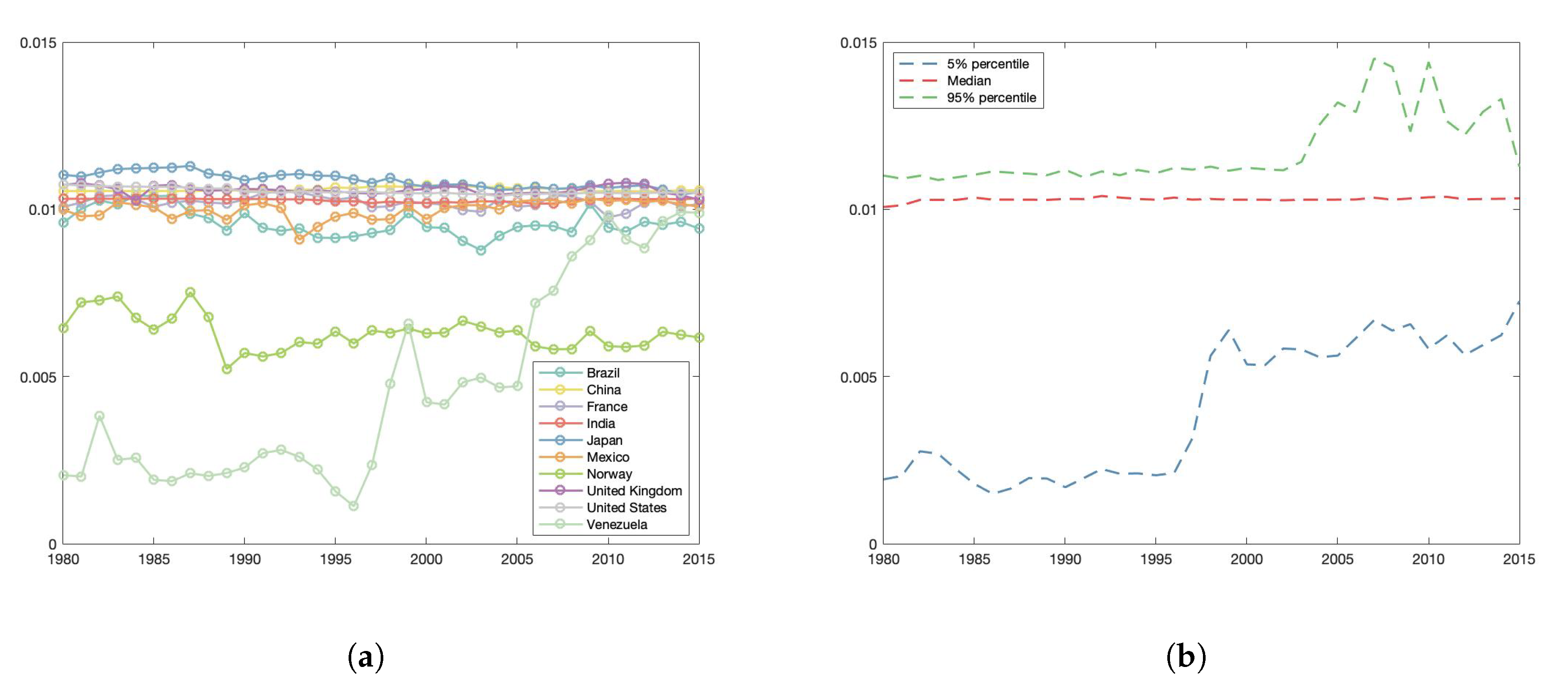

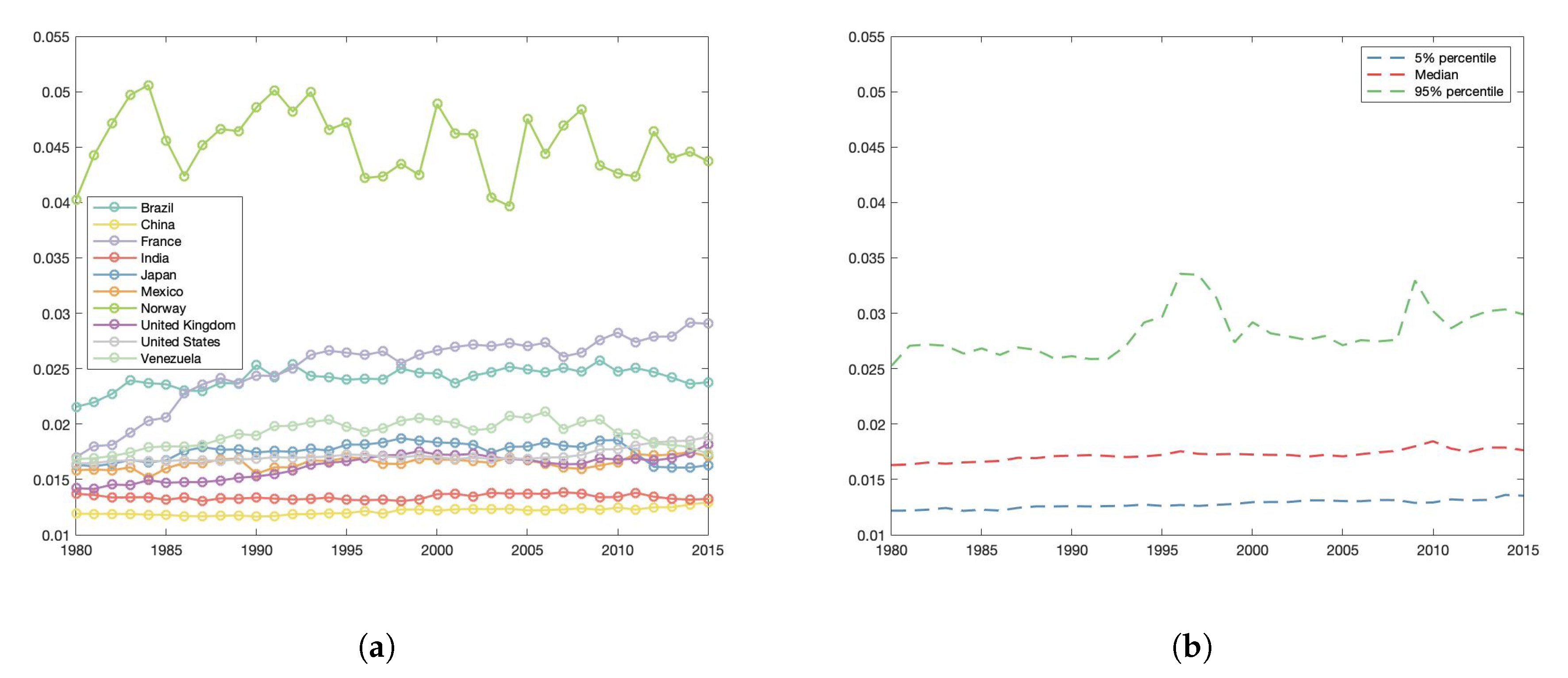
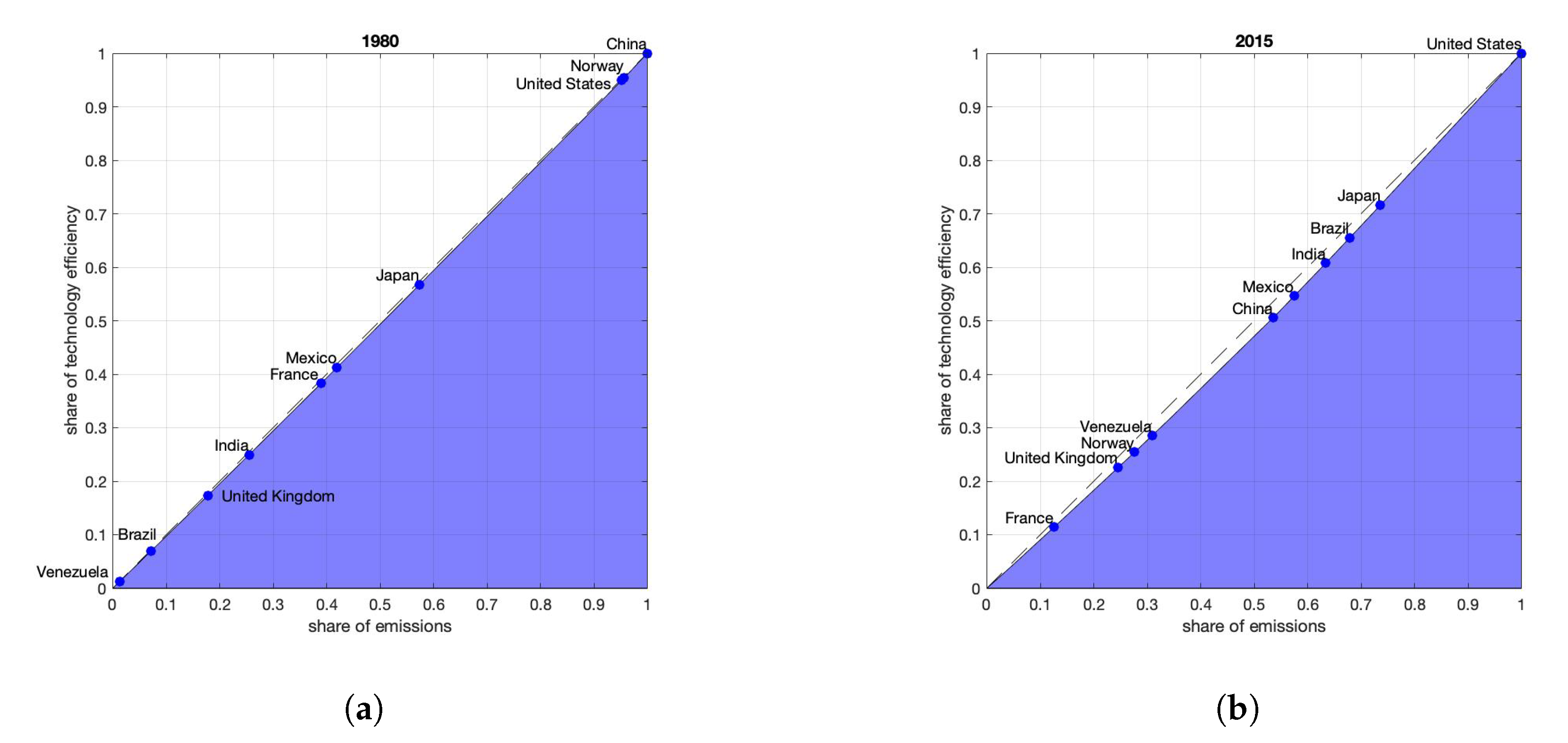
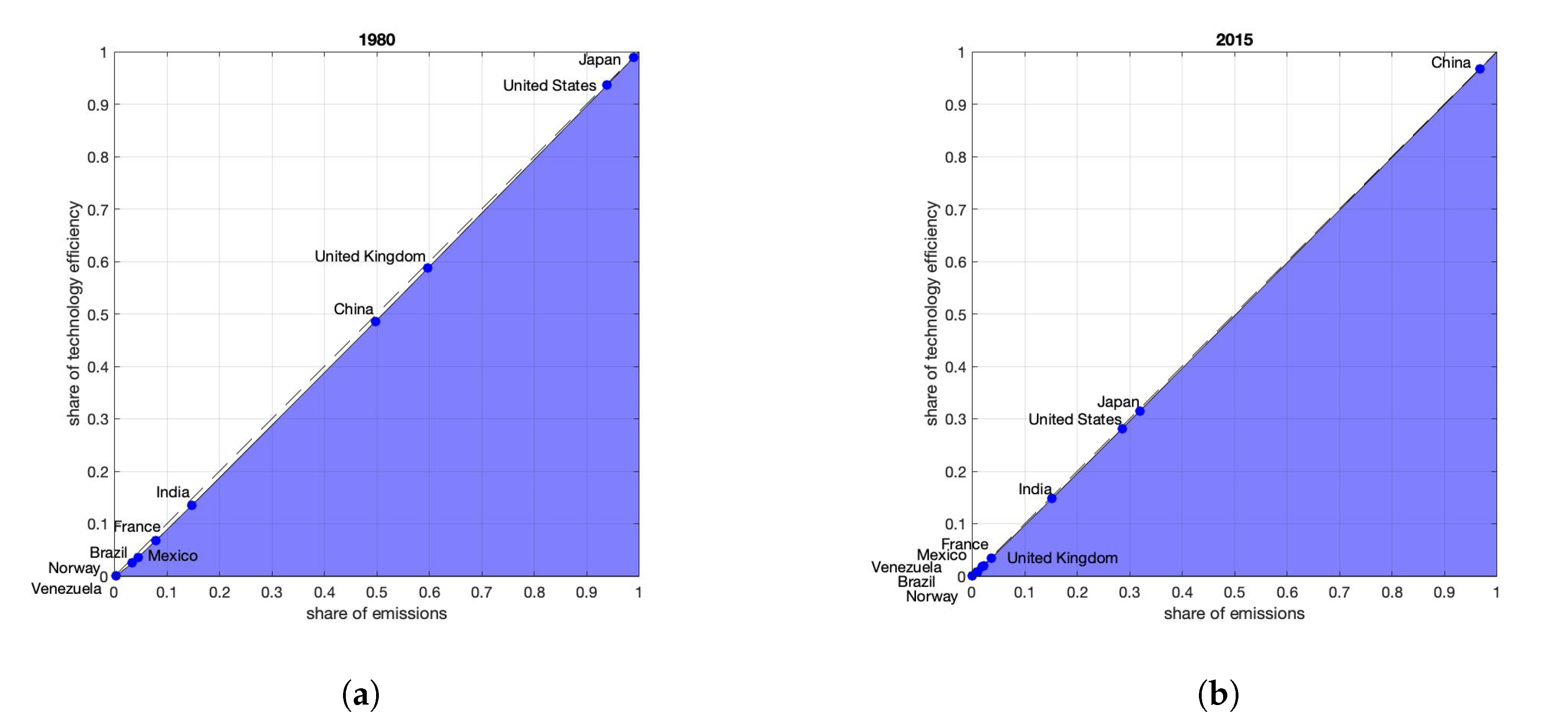
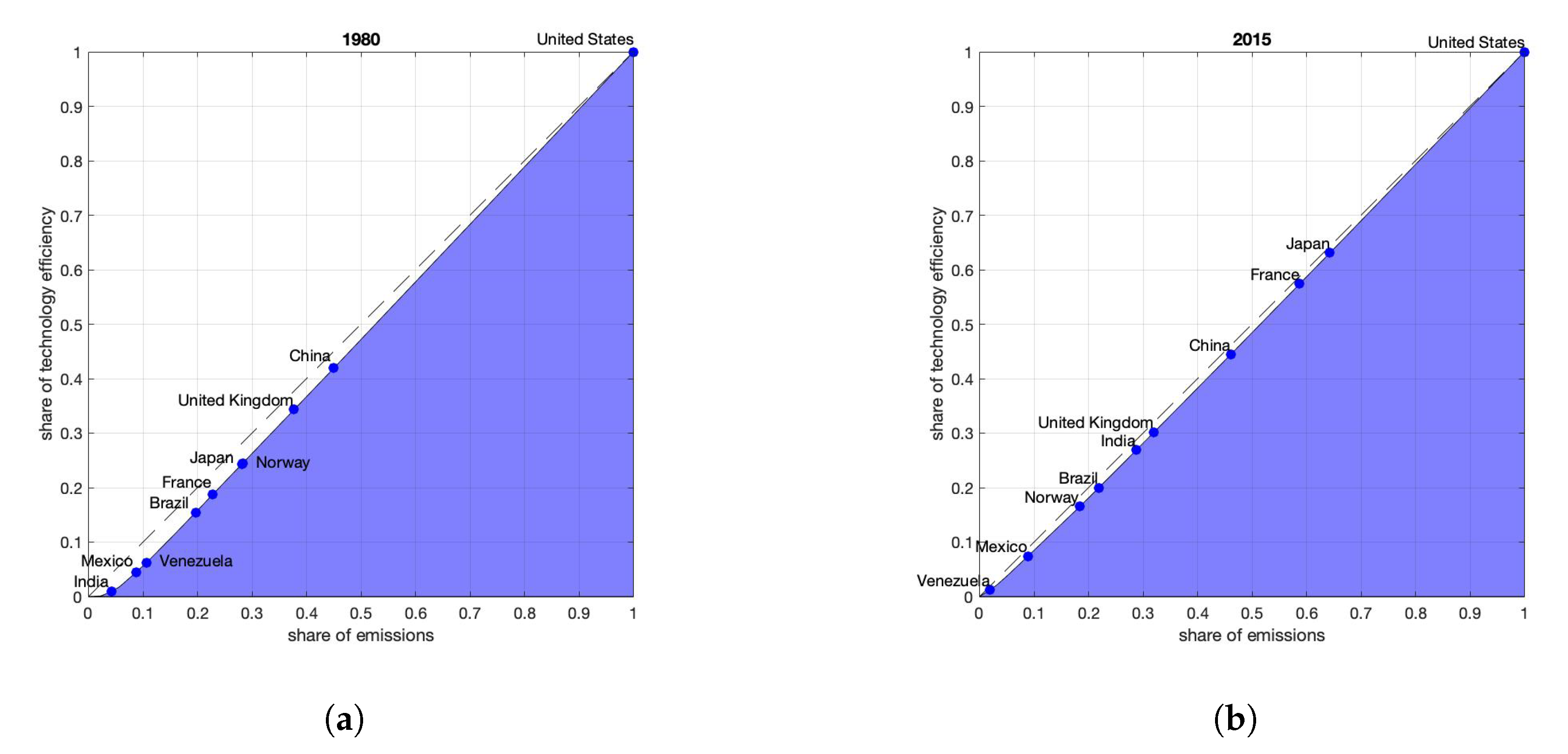
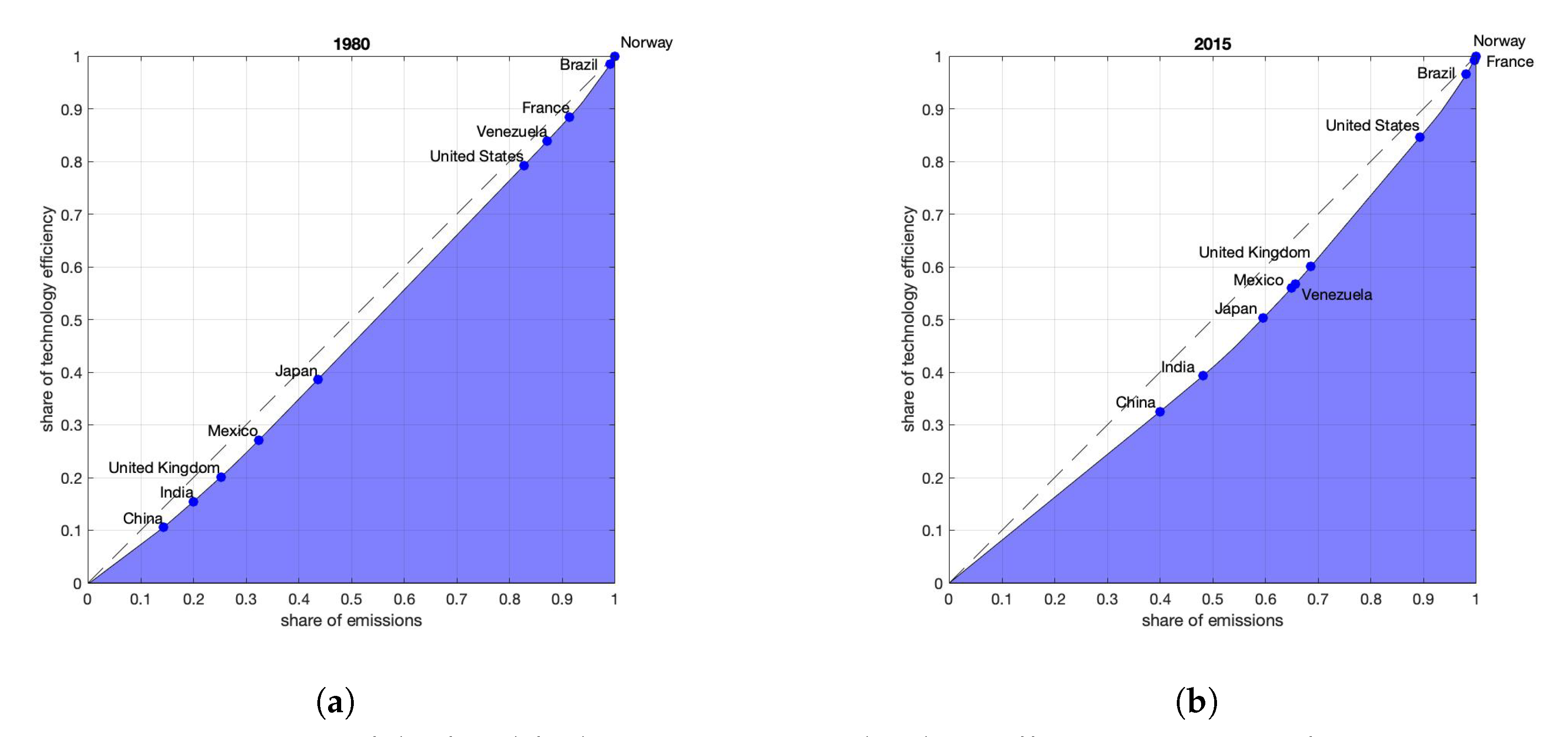

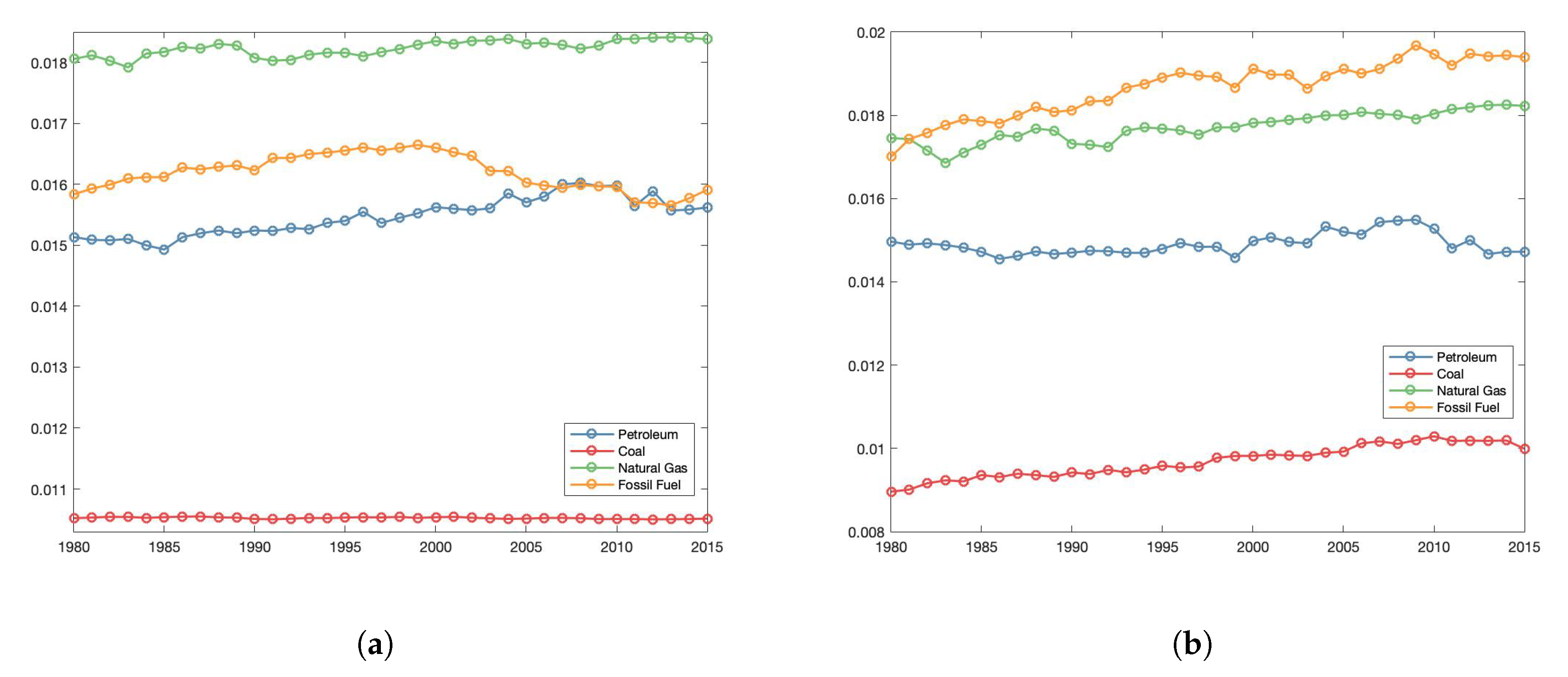
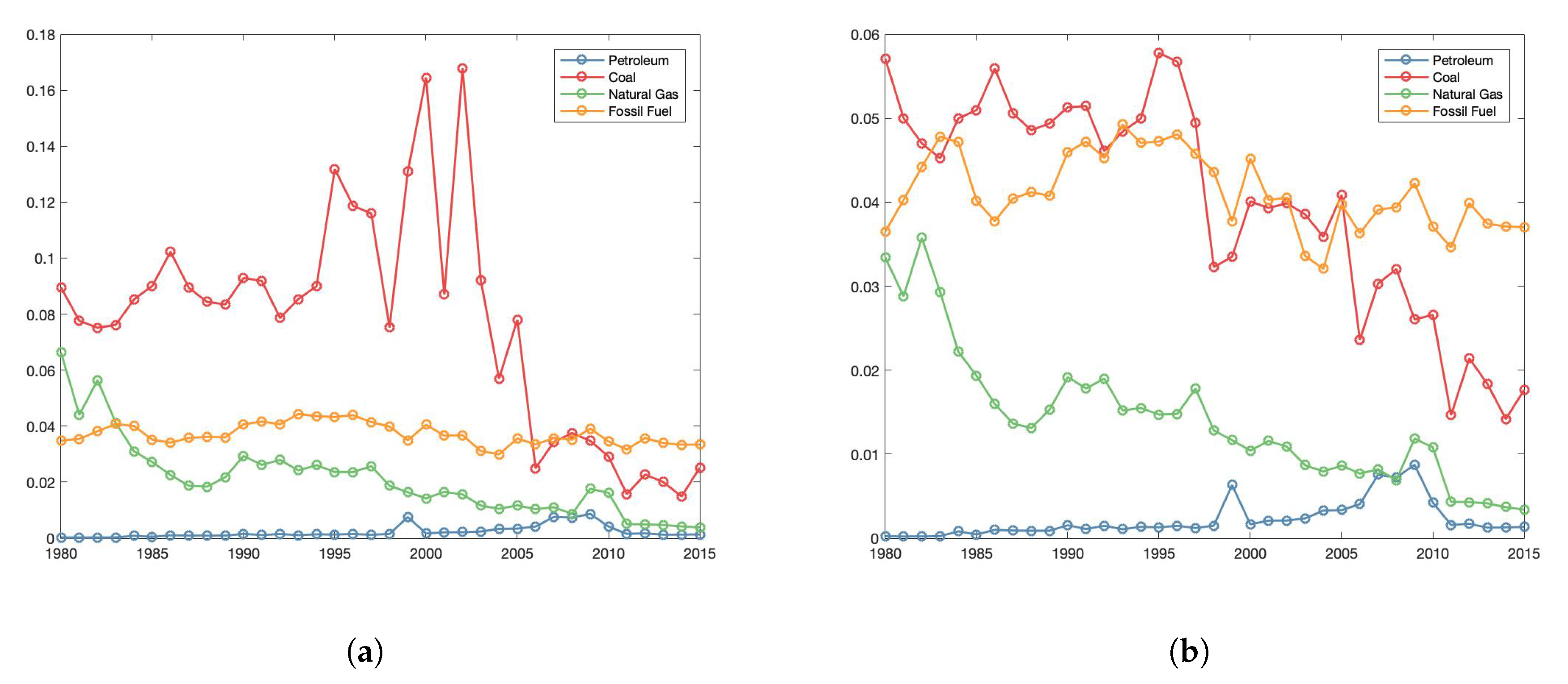

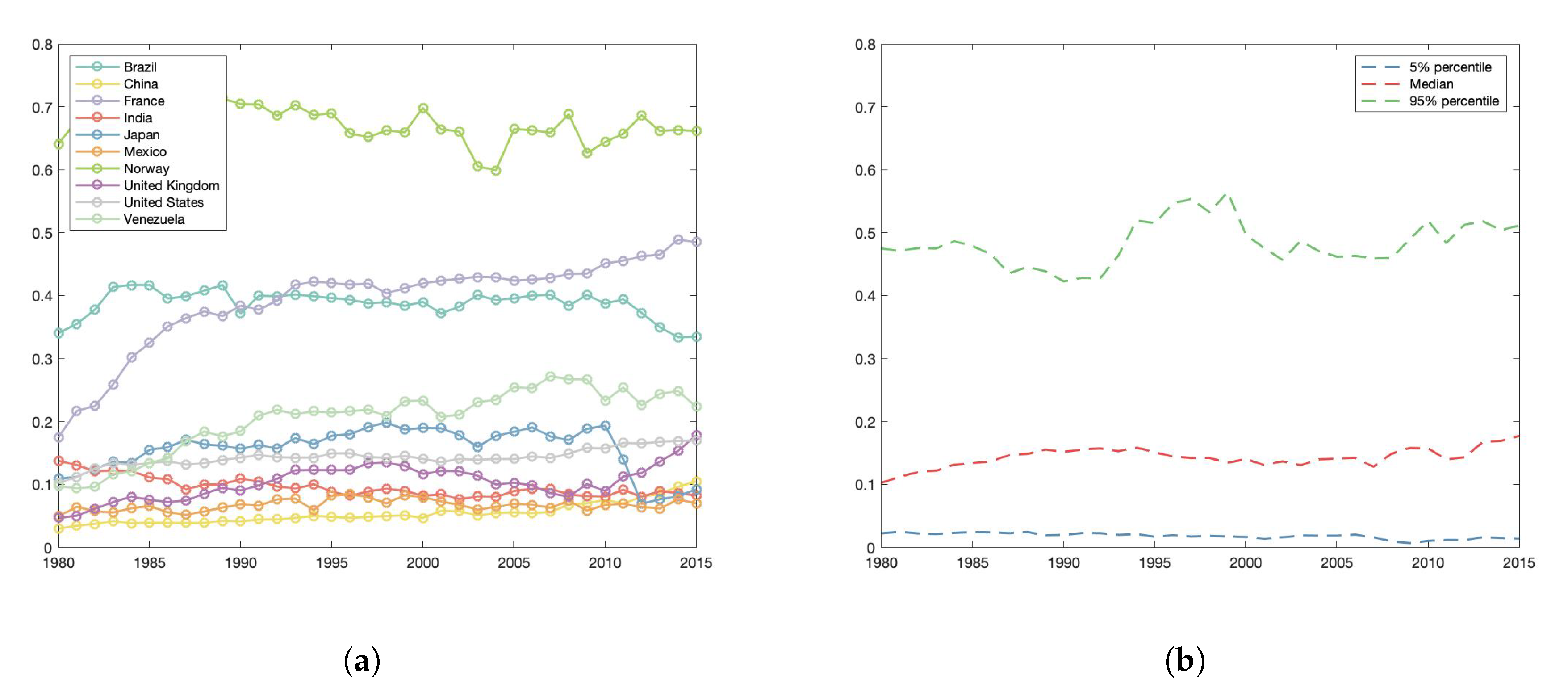

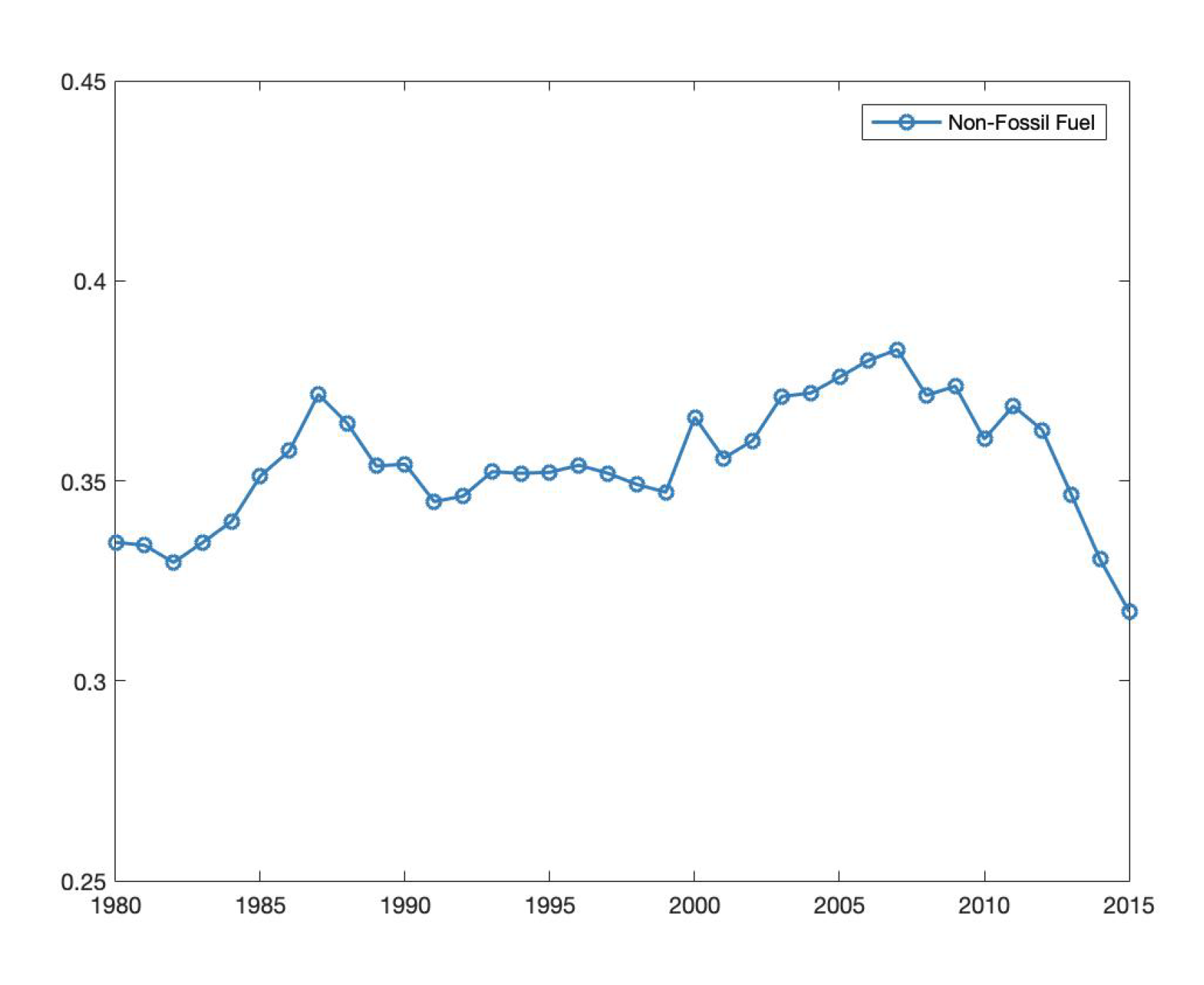


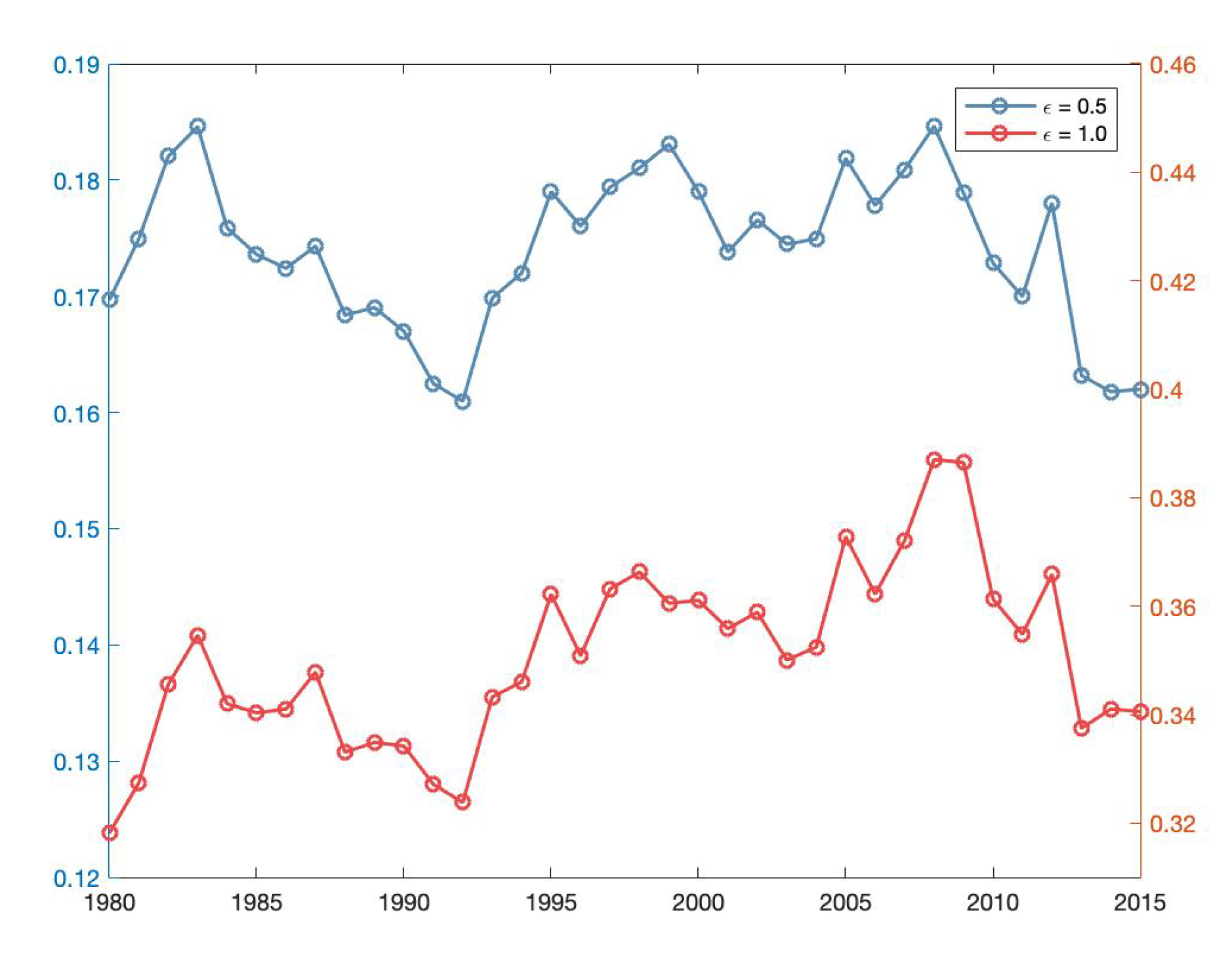
| Coefficient | Estimate | p-Value | Standard Error | t-Statistic |
|---|---|---|---|---|
| 0.155 | 0.017 | 0.062 | 2.513 | |
| 0.001 | 0.033 | 0.001 | 2.230 | |
| 0.084 | 0.002 | 0.025 | 3.408 | |
| −0.000 | 0.782 | 0.000 | −0.279 | |
| 0.077 | 0.207 | 0.059 | 1.288 | |
| 0.000 | 0.853 | 0.001 | 0.186 | |
| 0.118 | 0.027 | 0.051 | 2.316 | |
| 0.000 | 0.933 | 0.000 | 0.085 | |
| 0.126 | 0.002 | 0.037 | 3.400 | |
| −0.000 | 0.777 | 0.000 | −0.286 |
© 2020 by the authors. Licensee MDPI, Basel, Switzerland. This article is an open access article distributed under the terms and conditions of the Creative Commons Attribution (CC BY) license (http://creativecommons.org/licenses/by/4.0/).
Share and Cite
Takada, H.H.; Ribeiro, C.O.; Costa, O.L.V.; Stern, J.M. Gini and Entropy-Based Spread Indexes for Primary Energy Consumption Efficiency and CO2 Emission. Energies 2020, 13, 4938. https://doi.org/10.3390/en13184938
Takada HH, Ribeiro CO, Costa OLV, Stern JM. Gini and Entropy-Based Spread Indexes for Primary Energy Consumption Efficiency and CO2 Emission. Energies. 2020; 13(18):4938. https://doi.org/10.3390/en13184938
Chicago/Turabian StyleTakada, Hellinton H., Celma O. Ribeiro, Oswaldo L. V. Costa, and Julio M. Stern. 2020. "Gini and Entropy-Based Spread Indexes for Primary Energy Consumption Efficiency and CO2 Emission" Energies 13, no. 18: 4938. https://doi.org/10.3390/en13184938
APA StyleTakada, H. H., Ribeiro, C. O., Costa, O. L. V., & Stern, J. M. (2020). Gini and Entropy-Based Spread Indexes for Primary Energy Consumption Efficiency and CO2 Emission. Energies, 13(18), 4938. https://doi.org/10.3390/en13184938






